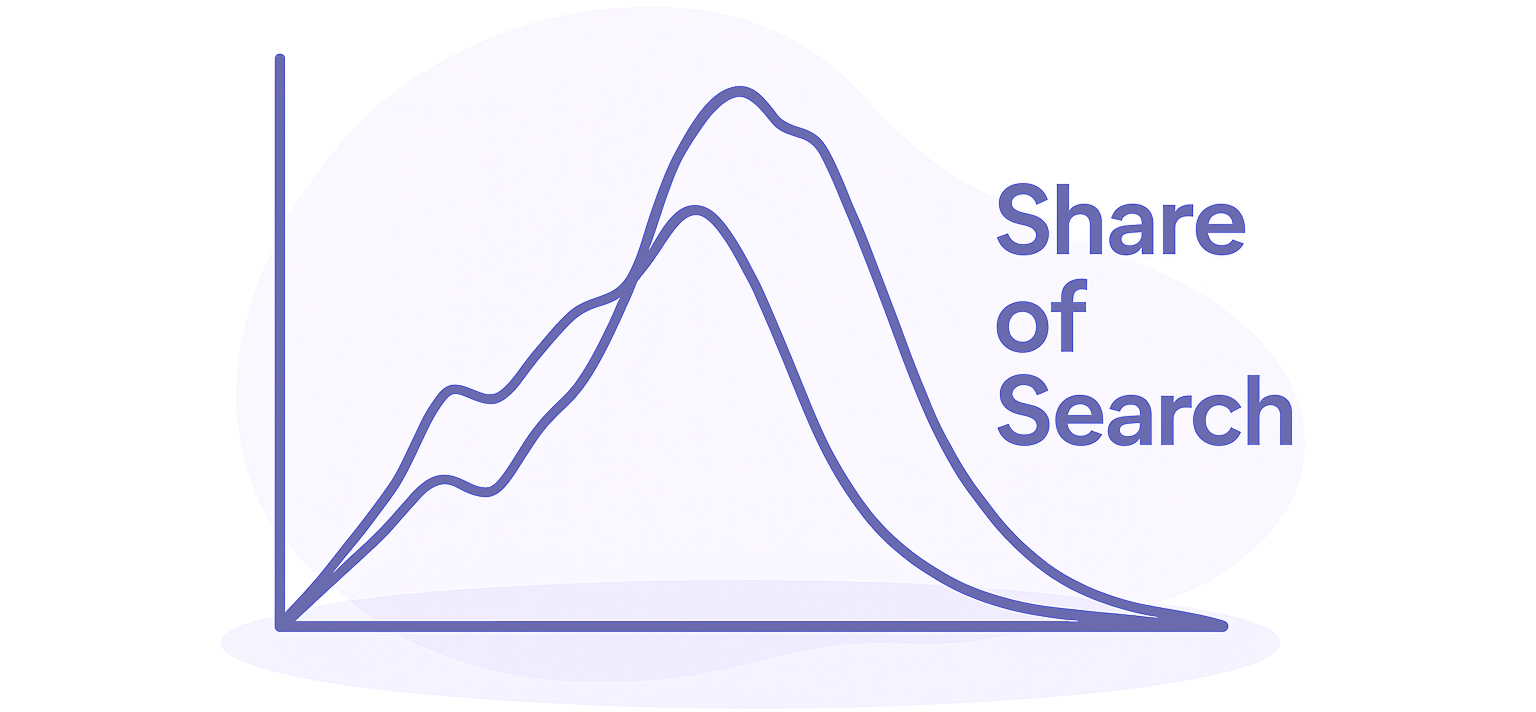
What Is Share of Search
Share of Search is the percentage of Google searches for a given brand or product compared to its competitors. It’s a proxy for consumer interest and in many cases, a leading indicator of market share.
Put simply, Share of Search is a brand's market share in terms of organic searches for a given category. So for example, if we pretend there are only 2 main searches that consumers are making when it comes to the sneaker category... "Nike sneakers" (let's pretend it got 8M searches per month) and "Adidas sneakers" (let's pretend it also got 8M searches per month), then Nike would have a 50% Share of Search in the sneakers category.
Formula

Share of Search vs Share of Voice vs Share of Market
Share of Search = % of search interest (market share in terms of organic searches)
Share of Voice = % of ad spend in your category (market share in terms of ads)
Share of Market = % of actual sales (market share in terms of sales)
While Share of Voice shows what brands say, Share of Search shows what people want. And unlike Share of Market, it’s forward-looking. In many cases, Share of Search today predicts Share of Market (A.K.A. Market Share) tomorrow.
Why It Matters
Because search behavior reflects intent. Whether it’s looking up product reviews, comparing prices, or checking availability - searches often precede purchases. Share of Search lets you track this early signal in near real-time.
Use Cases
Brand Tracking: Monitor shifts in consumer interest
Category Benchmarking: See how a brand stacks up over time relative to its competitors
Campaign Impact: Measure how much a campaign actually moved the needle
Market Entry: Spot fast-growing challengers before you lose sales to them
How to Calculate Share of Search
Formula
For a single point in time:

To track it over time, repeat the calculation for each time point (e.g., month or week).
Example
Say you're comparing three sneaker brands over the last 12 months (example data below):
Month | Nike | Adidas | New Balance |
Jan | 1.2M | 600K | 200K |
In January: Nike’s Share of Search = 60%, because 1.2M / (1.2M + 600K + 200K) = 60%.
Do this for each month, and you get a Share of Search over time.
Tools to Track Share of Search
Glimpse
The easiest way to track Share of Search over time is with Glimpse. Glimpse adds actual search volume numbers to Google Trends and lets you export time series data. You can input any brand list, normalize for seasonality, and track long-term shifts. It also highlights fast-growing competitors you might be missing entirely.
Google Trends
You can technically calculate Share of Search using Google Trends - but it’s more manual. Since Google Trends shows relative interest (0–100), you’ll need to:
Add all brands to a comparison
Choose one as the benchmark (it gets scaled to 100)
Download the data
Normalize the values
Convert to share percentages
Or, use Glimpse and save a few hours.
Best Practices & Notes
Watch out for ambiguous names: Searches for “Target”, for example, include both searches about the retailer and about shooting / aiming. Use exclusions if needed.
Choose keywords carefully: Use the actual brand name (e.g. "Apple"); don’t mix in product lines (e.g. “iPhone”) unless that's what you want to measure.
Compare within the same category: Comparing “Nike” to “Apple” won’t tell you much. Pick competitors that consumers might realistically substitute.
Normalize for seasonality: Some categories spike during holidays, others in summer. Look at YoY comparisons or apply seasonal smoothing.
Use time series (multiple datapoints over time), not point-in-time snapshots (single datapoints): A one-off number doesn’t mean much. Trends over time are what matter most.
Branded search ≠ brand equity: Searches for a brand reflect awareness and intent, but not necessarily favorability.
Intent vs. penetration: A high Share of Search might signal future growth - or just lots of curiosity. Interpret in context.
Non-Google channels matter too: People also search on TikTok, Amazon, Reddit. Share of Google Search is just one (albeit big) piece of the puzzle.
Low-volume brands can be noisy: Sampling in Google Trends can skew results for smaller brands. Use multi-month averages or a tool like Glimpse to smooth it out.